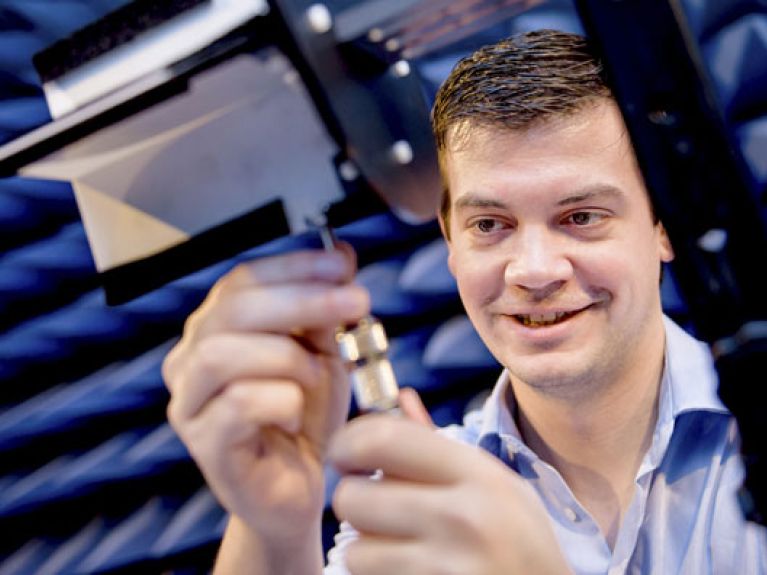Using open source to eradicate landmines
International Mine Awareness Day: How German researchers are helping Colombia to free itself from a deadly threat.

Germany is supporting Colombia in shaping its peace process – not least through cooperation in the fields of science and research. An enduring problem created by the decades of conflict is the many landmines still hidden in the ground. Engineers from German universities are cooperating with Latin American partners to develop a mobile detector which will identify mines constructed along very different lines. The technology will be freely available. Project manager Christoph Baer from the Ruhr-Universität Bochum explains how it works and what obstacles have to be overcome.
Mr Baer, Colombia is particularly affected by landmines. Why is that?
The landmines are left over from the armed conflict, which went on for more than 50 years. In the last 15 years, more than 10,000 Colombians have been injured or killed after stepping on mines. In 2016, the country had the sixth-highest number of landmine victims according to global statistics, behind countries such as Afghanistan and Syria. What is striking about Colombia is that the conflict was not a classic military one between armed forces. It was a guerrilla conflict, which means that the landmines used were not industrially manufactured, but largely hand built. They differ widely. The guerrilla movement is now helping to find them, but nobody knows exactly where the mines are located.
Can you give us an idea of what these landmines look like?
They are often frighteningly simple constructions, usually made of everyday objects. They consist of a container which holds the explosive material – either a tin can or a plastic bottle. The explosives themselves usually come from mining. They also have a fuse – which is the only industrially manufactured component of the landmines. For the mine to be activated, a contraption is needed that connects two metal contacts when it is stepped on. This triggers the explosion. Syringes or sponges are often used for this.
Why is it so difficult to locate these particular mines?
In Eastern Europe or Africa the task is hard enough, but the mines used there are generally similar. Once I have adapted the detection procedure to them, the identification process works well. That is not the case in Colombia. Until now, the Colombian military forces have been using conventional metal detectors. However, as a large amount of shrapnel and other waste is buried on field tracks and roads, the detectors are constantly sounding the alarm. On average only one in 2000 objects found is actually a landmine. There are also specially qualified experts who can trace landmines with ground penetrating radar devices, but training them is expensive and time-consuming. Moreover, given the large number of mines, it is unrealistic to consider deploying such experts throughout the country. Our goal is therefore to devise an automatic, mobile solution which is flexible and requires no specific training. Another problem in Colombia is that the mines are often located in dense forests or hilly terrain. That is why we want to devise a solution with the dimensions of a metal detector rather than a device that has to be attached to a vehicle.
You are cooperating with partners from the Technical University of Ilmenau, the Universidad de los Andes and the Universidad Nacional de Colombia in Bogotá. What approaches are you pursuing?
We are using high-resolution radar technology and are looking for certain signal patterns common to all the mines notwithstanding their differences – resonances that other objects do not display. To this end we are using Colombian military data, which catalogues mines that have already been found. We have been able to build safe versions of various mines for laboratory tests which very closely replicate the radar signature of the actual mines. We also create computer simulations of the mines, for example to find out how the different ground surfaces can affect the radar signal. The mines are usually buried up to 30 centimetres deep. As researchers, we are not able to manufacture a finished product ourselves, but we want to provide the basis for a detector to be built – both hardware prototypes and the algorithms to process the signals. For example, we have to take into account users’ movements when they sweep the device over the ground. Our work will be published in an open source format and is therefore patent-free. We want our work to be humanitarian and are not out to make a profit.
The cooperation is also leading to knowledge transfer. How does that work?
For instance, we have taken a multichannel ground penetrating radar device to Colombia and invented a special antenna for the required radar technology. The tests on our replicas take place in Colombia. But our cooperation is not restricted to research. We have concluded an agreement on undergraduate and doctoral student exchanges with the Universidad Nacional. This year, I am also running a summer school in radar technology in Bogotá. The two-week course is free and open to students from all universities. Landmines will be an issue for Colombia for many decades to come – but we hope that we can play a role in shortening this period.
The interview was conducted by Boris Hänßler.

